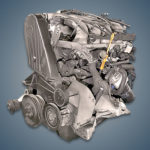The 2.6-liter gasoline V6 engine of the Audi ABC was produced by the company from 1992 to 1997 and was installed on such popular concern models of its time as 80, 100, A4 and A6 C4. There is a derated version of this power unit under its own ACZ index.
The EA835 series includes: ABC, AAH, ALF, BDV, ARE, ACK, ALG, BBJ, ASN.
In the early 90s, Audi developed a whole line of V-shaped 6-cylinder units and, since they were created on the basis of a V8 engine, they have a camber angle of 90 °. In 1990, a 2.8-liter AAN engine appeared, and two years later, the ABC engine we are describing. Structurally, there is a cast-iron cylinder block with a pair of SOHC cylinder heads and hydraulic lifters, conventional distributed fuel injection and a timing belt drive that also rotates the pump.
There is also an absolute pressure sensor + air temperature sensor instead of a flow meter, an ignition coil of 3 dual modules, only a pair of lambda probes and an intake manifold equipped with a geometry change system.
Specifications
| Production years | 1992-1997 |
| Displacement, cc | 2598 |
| Fuel system | distributed injection |
| Power output, hp | 150 |
| Torque output, Nm | 225 |
| Cylinder block | cast iron V6 |
| Block head | aluminum 12v |
| Cylinder bore, mm | 82.5 |
| Piston stroke, mm | 81 |
| Compression ratio | 10.0 |
| Features | 2 x SOHC |
| Hydraulic lifters | yes |
| Timing drive | belt |
| Turbocharging | no |
| Recommended engine oil | 5W-30, 5W-40 |
| Engine oil capacity, liter | 5.0 |
| Fuel type | petrol |
| Euro standards | EURO 2 |
| Fuel consumption, L/100 km (for Audi A6 C4 1995) — city — highway — combined |
12.5 7.0 8.6 |
| Engine lifespan, km | ~400 000 |
| Weight, kg | 160 |
The engine was installed on:
- Audi 80 B4 (8C) in 1992 – 1995;
- Audi 100 C4 (4A) in 1992 – 1994;
- Audi A4 B5 (8D) in 1994 – 1997;
- Audi A6 C4 (4A) in 1994 – 1997.
Disadvantages of the Audi ABC engine
- Most of the complaints on specialized forums are related to progressive oil consumption. Consumption appears closer to 200,000 km after the wear of the oil scraper rings and caps. But if replacing them does not help, then sharpening the cylinders is problematic due to thin walls.
- According to the regulations, the timing belt changes every 90,000 km, but it may burst earlier and then bending of the valves cannot be avoided. Most often, the use of non-original spare parts or a jammed water pump, which is driven here by the same belt, is to blame.
- Quite often, owners are faced with the unstable operation of their power unit. The main culprits for this are air leaks through the pipes or through the intake, as well as severe contamination of the idle speed controller or failure of the throttle assembly potentiometer.
- Also, there are often leaks of lubricant through the valve covers and the heat exchanger, flowing nozzles, and also the curvature of the mating surface of the exhaust manifold. For uncertain starts, check the fuel pressure regulator filter and ECU firmware.







hello, I have an Audi A6 C4 2.6 quattro, year of manufacture 1996, I have a problem with the air, my water has started to boil and I have sent it to the mechanic, I have carved it, I have changed all the gauges, the spark plugs, the thermostat, but… the same thing, now it doesn’t seal the water, but the antifreeze pipe swells so much that it once cracked my pipe, except for the water pump, which I haven’t changed (I changed the water pump earlier with a complete toothed belt, but the pump is missing original firm) all the others, is there any sensor that has the possibility to use air.
I have had a problem with boiling aswell, turned out radiator was almost sealed with sludge. Tried a radiator flush but that completely closed it and i had to change the radiator